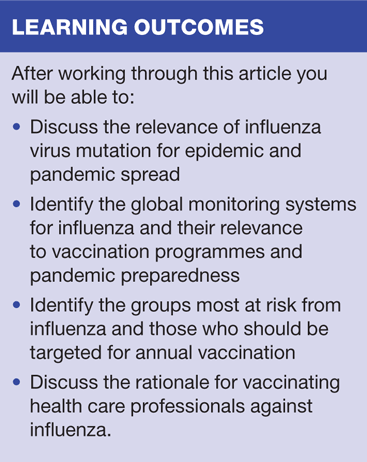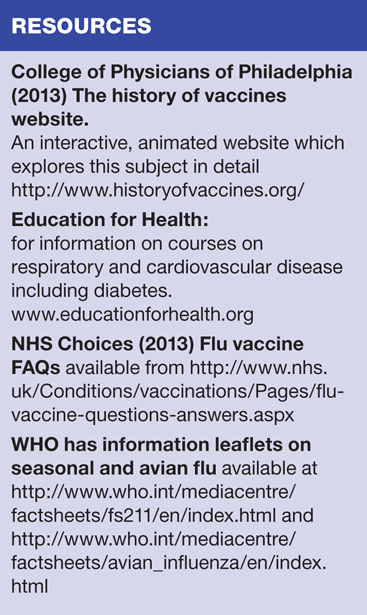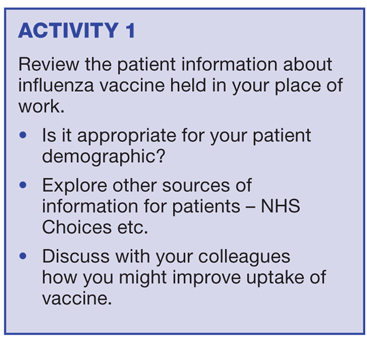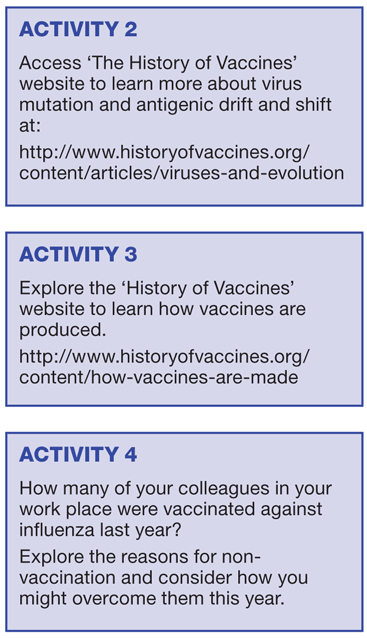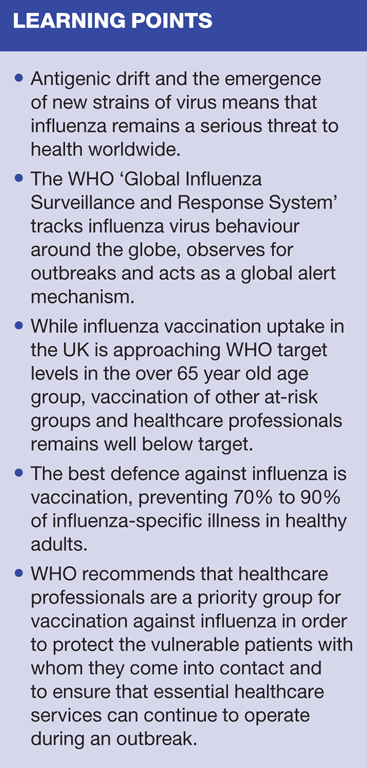How viruses attack: The story and history of influenza
Beverley Bostock-Cox
Beverley Bostock-Cox
RGN, BSc, MSc
Nurse Practitioner, Sky Blue Medical Group, Coventry & Mann Cottage Surgery,
Moreton-in-Marsh
Clinical Lead, Education for Health, Warwick
History demonstrates that influenza can cause devastating pandemics. Healthcare systems and healthcare professionals in the UK and around the world need to be prepared for the next pandemic, when (not if!) it arrives
The 'flu vacc' season seems to come around quicker and quicker every year. It seems that no sooner have we put away the ubiquitous boxes of vaccine than we are preparing for the following year's campaign. As summer comes to a close, the call to 'Man the flu vaccine stations!' is heard loud and clear across the country. Suddenly winter seems to be just around the corner"¦ which can feel a little depressing.
We should not, however, lose sight of just how important this time of year can be. Health care professionals are instrumental in encouraging influenza vaccine uptake. We also need to address the general public's perception of influenza as an unpleasant, yet relatively minor illness. It may be minor for young, fit and healthy people, but it can be extremely serious, or fatal, in some people. In the 2011-12 season, the Health Protection Agency reported that excess all-cause mortality was limited to the over 65 year age group, with the excess deaths coinciding with peak respiratory syncytial virus (RSV) and influenza virus activity in December and February respectively.1
The latest available influenza vaccine uptake data, from the winter of 2011-12, show that vaccine uptake in people over 65 was 73.4%, just short of the 75% target. For patients aged 6 months to 65 years in a clinical risk group uptake stood at 51.3%, well below target. Both of these figures were down on the previous year. Uptake in pregnant women, however, increased from 27.4% in 2011-12 to 40.3% in 2012-13, which suggests that, although the level of vaccination is still well below target, the message is starting to get through to this particular at-risk group.
The influenza virus was first isolated in a laboratory 80 years ago, although the history books have recorded flu outbreaks for hundreds of years. Although influenza is generally a relatively short-lived illness (most people will recover within a few days to a week) the symptoms can be severe, with pyrexia, myalgia and fatigue. In those most at risk, such as the very young and elderly, pregnant women and people with long term conditions, such as diabetes, cardiovascular disease and lung conditions, there is an increased risk of hospitalisation and even death.
This article discusses the magnitude of influenza's threat to health and assesses the impact of this largely preventable condition. It will also cover how influenza activity is monitored globally in order to provide the best possible protection against an infectious disease, which can, in too many cases, prove fatal.
HOW VIRUSES ATTACK
Viruses are micro-organisms which contain a set of genetic instructions embedded in nucleic acid (DNA or RNA) and protected by a protein coat. They can only survive and replicate with the help of a host cell, such as those found in plants or animals. The human body can be invaded by the influenza virus via the nose or mouth in droplets carried by other infected persons. The influenza virus is an 'enveloped virus', which means it is surrounded by a lipid membrane which allows it to move through the host cell membrane and implant its contents directly into the cell in order to take it over. At this point the virus hijacks the host cell, turning it into a virus factory that reproduces and replicates thousands of new viruses.
When someone with influenza coughs or sneezes virus is expelled in droplet form. The virus-containing droplets can be inhaled by an uninfected person where the virus attaches to cells in the nose attacking them and replicating. The new viruses generated in the host cells continue to replicate and spread throughout the respiratory, gastrointestinal and circulatory systems causing headaches, sore throat, muscle aches and rhinitis. Each time the new host sneezes or coughs the spread of infection continues.
Many viruses will be captured in the mucus that lines the respiratory system or deactivated by mast cell activity. These are the first-line defences against inhaled viruses. Antibodies, made by the immune system via white bloods cells, stop the spread of the infection by preventing the ability of the virus to move through the cell membrane and implant its contents into the host cell. Antibodies are the second line of defence and, in an unvaccinated individual, take time to muster.
DEFENCE AGAINST VIRUS INFECTION
The best defence against the influenza virus is vaccination. It takes 10-14 days for the immune system to respond to the vaccine and develop an antibody response that will protect against the virus. The earlier the vaccine is given the greater the chance of protection developing before the virus begins to circulate.
Influenza virus is also inactivated by soap. Effective hand washing is vital to prevent spread. Covering the mouth and nose when coughing and sneezing is always recommended but washing hands afterwards is just as important.
Antibiotics have no effect because they are designed to interfere with the way bacteria reproduce and influenza is a virus. However, bacterial infections may occur alongside the viral infection. Decisions about whether to prescribe antibiotics will need to be made on an individual basis following a careful assessment.
VIRUS MUTATION AND GLOBAL MONITORING
It has long been recognised that the influenza virus is capable of mutation. The mutations, also known as antigenic drift, mean that previous infection or immunisation with the vaccine will be ineffective against the mutated strain. Even a modest alteration in the genetic make-up of the 'new' virus will leave a population unprotected. Outbreaks of influenza can then spread quickly, through droplet spread, and result in epidemics and pandemics.
There are two glycoproteins, haemaglutinin (HA) and neuraminidase (NA), on the surface of the virus. Antibody to these glycoproteins is required to confer immunity.2 When the virus mutates, it alters these glycoproteins, particularly HA. The development of effective vaccines is based on the monitoring of antigenic drift and shift,3 as well as the appearance of new virus subtypes, in order to ensure that the vaccine is able to protect against them.
This important monitoring work is carried out by the World Health Organization's Global Influenza Surveillance and Response System (GISRS) which tracks influenza virus behaviour around the globe and observes for outbreaks.4 GISRS also acts as a global alert mechanism via FluNet, a publically available and up to date monitoring system available on the WHO website. Information is gathered via an international network of National Influenza Centres (NICs) and the information from each NIC forms the basis for WHO recommendations on the composition of influenza vaccine each year, as well as relevant risk assessment activities of WHO.5 In the United Kingdom there are NICs in Aberdeen, Belfast, Glasgow and London. There is also one in Dublin.
EPIDEMICS AND PANDEMICS
An 'epidemic' of influenza refers to an outbreak which is contained in one specific area, such as a country. Once an outbreak spreads beyond this confined area it becomes a pandemic. In a pandemic, the infection will have started in a specific area as an epidemic but then spread throughout multiple continents, or even globally, often with high mortality rates.
An influenza pandemic is caused by a new subtype of a type A influenza virus, rather than a mutation. In the case of a pandemic, WHO has an international Pandemic Influenza Preparedness (PIP) Framework in place to ensure that information is shared and vaccines are made accessible to the areas affected as quickly and effectively as possible.6
INFLUENZA PANDEMICS — LESSONS FROM HISTORY
'Spanish flu', which struck in 1918, was a particularly virulent form of the disease. An army cook is thought to have been one of the first victims, but within hours of his becoming ill soldiers in his company were also succumbing to the infection at an alarming rate. People went from being apparently well to severely unwell and dying within hours. They also exhibited distressing symptoms, such as violent coughing fits producing blood-stained, frothy sputum, and turning blue (cyanotic). The infection spread across Europe, Russia, Africa, India and China and it is estimated that between 40 and 70 million people, often in their twenties, died before the virus eventually disappeared.
'Asian flu' was first recognised in the late 1950s and around 2 million people worldwide are thought to have died as a result of contracting the infection.
The 'Hong Kong flu' pandemic, from 1968-9, was less serious in terms of mortality but still had a high infection rate. One of the main problems was that, even at this time, there was no international monitoring system in place to identify and alert against epidemics and pandemics.
The 2009 'Swine flu' pandemic killed between ¼ and ½ million people — figures are difficult to quantify as many who died had no access to health care facilities that could confirm the virus as being present and contributing to death. Unusually, most of the deaths were in people under the age of 65. Around 90% of seasonal influenza deaths usually occur in people over 65, whereas 87% of deaths in the 2009 pandemic occurred in people under 65 years of age.
In contrast to the 'Hong Kong flu' pandemic, the 2009 pandemic provoked accusations of an 'information overload' and 'doom mongering'. Some people thought the authorities caused unnecessary anxiety after death rates turned out to be lower than predicted. The counter argument to these views is that the organised and concerted effort that was made to identify and respond to this pandemic may have helped to keep mortality rates down.
THE VACCINE
The first vaccine against influenza was developed in the 1940s and used on soldiers in the Second World War. The WHO decides on the recommended mixture of viruses for that year's vaccine for the whole of the northern hemisphere, based on the information they receive during that year. An announcement is made in February and the companies who manufacture the vaccine start production. Distribution of vaccine takes place around September and the new 'flu campaign' begins.
The vaccine will contain a mixture of viruses, treated during the manufacturing process so that they are only present in the vaccine in an inactivated (killed) form. Vaccines often include one or more type A virus, since these are the most dangerous. Type A viruses cause the most serious type of influenza with the greatest risk of morbidity and mortality. Type B is less serious but tends to affect children more often. People who succumb to a type C virus will often suffer only mild symptoms, similar to the common cold.
As usual, the viruses in this year's vaccine include two type A viruses and one type B.7 The details of the viruses are listed on the WHO website and are:
- An A/California/7/2009 (H1N1)pdm09-like virus.
- An A(H3N2) virus antigenically like the cell-propagated prototype virus A/Victoria/361/2011
- A B/Massachusetts/2/2012-like virus.8
- In addition, the UK vaccine will contain an influenza B/Brisbane/3/2007 (Yamagata) — the first time a quadrivalent vaccine will be available.
VACCINATION FOR HEALTH CARE PROFESSIONALS
The WHO's Strategic Advisory Group of Experts (SAGE) on Immunization has advised that priority groups for influenza vaccination include healthcare workers, as well as children aged 6 months to 5 years of age, the elderly and people with high-risk conditions. Although higher than in the previous year, the latest statistics show that just under half of health care professionals were vaccinated against influenza last year.
The rationale for vaccinating health care workers came from studies that showed that they have an increased risk of infection compared with the general adult population and that nurses seemed to be at particularly high risk. Health care workers also tended to come to work even if they were unwell, thus exposing vulnerable patients to the virus.9 Statistics from the SAGE group indicate that the vaccine can prevent 70% to 90% of influenza-specific illness in healthy adults and, perhaps more importantly in the case of health care professionals, reduce the risk of influenza being passed on to 'at risk' groups by increasing herd immunity. In this way vulnerable people who are unable to have the vaccine can still be offered protection.
One of the most important things a health care professional can do is to ensure that their patients have clear, unequivocal advice about influenza and the vaccine. This could begin with the '10 myths about the flu jab' webpage on the NHS Choices website.10 They should also lead by example; being vaccinated themselves in order to protect the vulnerable people with whom they come into contact.
SUMMARY
History has demonstrated how devastating the influenza virus can be. Its continued ability to morph from one mutation to another, along with the birth of new sub-types, means that the risk remains. It is not a matter of 'if' there is another major pandemic with potential to claim millions of lives, but 'when'. International collaboration enables us to monitor influenza activity, assess the virus types that carry the greatest risk and prepare effective vaccines against that risk. All that remains is for the vaccine to be used.
Health care professionals have a vital role in helping people to understand the benefits and risks of vaccination and encouraging uptake of vaccine in those vulnerable groups who will be at most risk when the next epidemic or pandemic arrives.
REFERENCES
1. Health Protection Agency. Annual report. 2012. http://www.hpa.org.uk/Publications/InfectiousDiseases/Influenza/1206influannualreport/
2. Potter CW. A history of influenza. Journal of Applied Microbiology 2001; 91: 572-579
3. College of Physicians of Philadelphia. Viruses and Evolution. 2013. http://www.historyofvaccines.org/content/articles/viruses-and-evolution
4. WHO. Global Influenza Surveillance and Response System (GISRS). 2013. http://www/who.int/influenza/gisrs_laboratory/en/
5. WHO. National Influenza Centres. 2013 http://www.who.int/influenza/gisrs_laboratory/national_influenza_centres/en/
6. WHO. Pandemic Influenza Preparedness Framework. 2013. http://www.who.int/influenza/pip/en/
7. NHS Choices How the adult flu vaccine works. 2012 http://www.nhs.uk/conditions/vaccinations/pages/how-flu-vaccine-works.aspx
8. Department of Health and Public Health England. Flu immunisation programme 2013/14. https://www.gov.uk/government/publications/flu-immunisation-programme-2013-to-2014
9. WHO. Influenza Disease Burden. 2012. http://www.who.int/immunization/sage/meetings/2012/april/1_J.Bresee_SAGE_DB_Final.pdf
10. NHS Choices. 10 myths about the flu jab. http://www.nhs.uk/Livewell/winterhealth/Pages/Flu-myths.aspx

